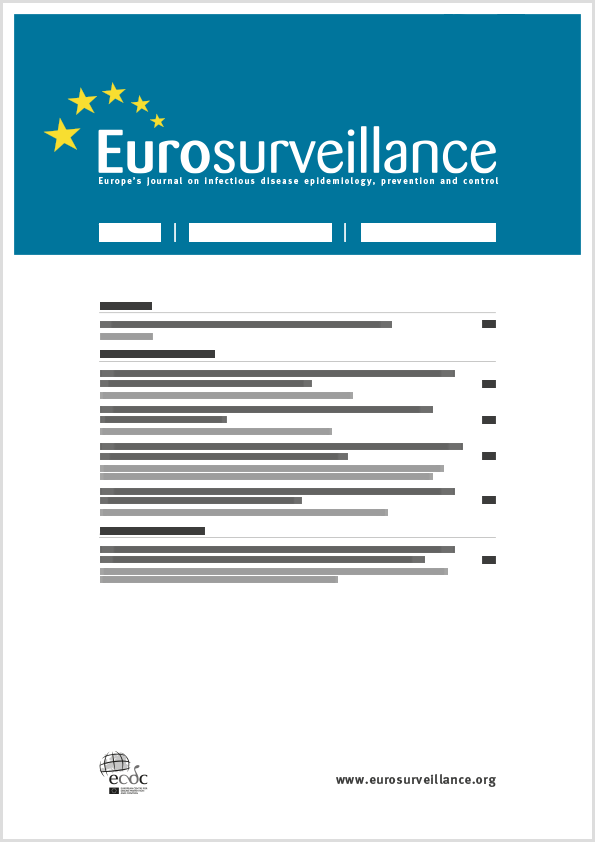- Home
- Eurosurveillance
- Previous Issues
- Volume 23, Issue 31, 02/Aug/2018
Eurosurveillance - Volume 23, Issue 31, 02 August 2018
Volume 23, Issue 31, 2018
- Research article
-
-
-
Epidemiology and resistance phenotypes of carbapenemase-producing Klebsiella pneumoniae in Greece, 2014 to 2016
Irene Galani , Ilias Karaiskos , Irene Karantani , Vassiliki Papoutsaki , Sofia Maraki , Vassiliki Papaioannou , Polyzo Kazila , Helen Tsorlini , Nikoletta Charalampaki , Marina Toutouza , Helen Vagiakou , Konstantinos Pappas , Anna Kyratsa , Konstantina Kontopoulou , Olga Legga , Efthymia Petinaki , Helen Papadogeorgaki , Efrosini Chinou , Maria Souli , Helen Giamarellou and on behalf of the study collaboratorsMore LessBackground and aimA multicentre nationwide surveillance study was conducted in Greek hospitals to evaluate epidemiology of carbapenemase-producing Klebsiella pneumoniae clinical isolates, and their susceptibilities to last-line antibiotics. Methods: Minimum inhibitory concentrations (MICs) were evaluated by Etest, colistin MICs were also evaluated by broth microdilution SensiTest (now known as ComASP) Colistin. Carbapenemase genes were detected by PCR. Clonal relatedness was assessed by PFGE. Isolates were prospectively collected between November 2014 and April 2016, from 15 hospitals. Results: Among 394 isolates, K. pneumoniae carbepenemase (KPC) remained the most prevalent carbapenemase (66.5%). NDM was the second most prevalent (13.7%), identified in 12 hospitals, followed by VIM (8.6%). OXA-48- and double carbapenemase-producers remained rare (3.6%, 6.3%, respectively). Carbapenemase-producing K. pneumoniae isolates showed high resistance to last-line antibiotics. Gentamicin and colistin were the most active in vitro with 61.9% and 59.6% of the isolates to be inhibited at ≤ 2mg/L, followed by fosfomycin (susceptibility (S): 58.4%) and tigecycline (S: 51.5%). Ceftazidime/avibactam inhibited 99.6% of KPC and 100% of OXA-48-like-producing isolates, while temocillin was active against 58% of KPC isolates at urinary breakpoint of ≤ 32mg/L* and only 2.7% at systemic breakpoint of ≤ 8mg/L. NDM-producing isolates belonged mainly to one clone, whereas KPC, VIM, OXA-48 and double carbapenemase-producers were mainly polyclonal. Conclusions: KPC remains the predominant carbapenemase among K. pneumoniae in Greece, followed by NDM, whereas changing trends of resistance rates to last-line antimicrobials against carbapenemase-producing K. pneumoniae with the exception of ceftazidime/avibactam mandates continuing surveillance to support clinical practice.
-
- Top
-
- Surveillance and outbreak report
-
-
-
A national measles outbreak in Ireland linked to a single imported case, April to September, 2016
More LessEndemic measles transmission was interrupted for the first time in Ireland in 2015. In May 2016, a case of measles was confirmed in an adult who had travelled from Hungary to Ireland (index case). Cases subsequently arose in five of the eight public health regions around the country. There were 40 confirmed cases in Ireland between April and September 2016. All sequenced cases were genotype B3. Vaccination status was known for 34 cases, of whom 31 were unvaccinated. Median age was 8 years (range: 3 months to 40 years). Ten cases were nosocomial, and three cases were infected on separate international flights. One linked case occurred in a resident of Slovenia. Nineteen cases were hospitalised; median duration of hospitalisation was 5 days (range: 2–8 days). The primary case was a child who travelled from Romania to Ireland via Budapest, and infected the index adult case on the same flight. This was the first reported outbreak of measles genotype B3 in Ireland. This outbreak demonstrated that Ireland remains at risk of measles outbreaks due to persistent suboptimal vaccination rates.
-
-
Volumes & issues
-
Volume 29 (2024)
-
Volume 28 (2023)
-
Volume 27 (2022)
-
Volume 26 (2021)
-
Volume 25 (2020)
-
Volume 24 (2019)
-
Volume 23 (2018)
-
Volume 22 (2017)
-
Volume 21 (2016)
-
Volume 20 (2015)
-
Volume 19 (2014)
-
Volume 18 (2013)
-
Volume 17 (2012)
-
Volume 16 (2011)
-
Volume 15 (2010)
-
Volume 14 (2009)
-
Volume 13 (2008)
-
Volume 12 (2007)
-
Volume 11 (2006)
-
Volume 10 (2005)
-
Volume 9 (2004)
-
Volume 8 (2003)
-
Volume 7 (2002)
-
Volume 6 (2001)
-
Volume 5 (2000)
-
Volume 4 (1999)
-
Volume 3 (1998)
-
Volume 2 (1997)
-
Volume 1 (1996)
-
Volume 0 (1995)
Most Read This Month

-
-
Detection of 2019 novel coronavirus (2019-nCoV) by real-time RT-PCR
Victor M Corman , Olfert Landt , Marco Kaiser , Richard Molenkamp , Adam Meijer , Daniel KW Chu , Tobias Bleicker , Sebastian Brünink , Julia Schneider , Marie Luisa Schmidt , Daphne GJC Mulders , Bart L Haagmans , Bas van der Veer , Sharon van den Brink , Lisa Wijsman , Gabriel Goderski , Jean-Louis Romette , Joanna Ellis , Maria Zambon , Malik Peiris , Herman Goossens , Chantal Reusken , Marion PG Koopmans and Christian Drosten
-
- More Less


